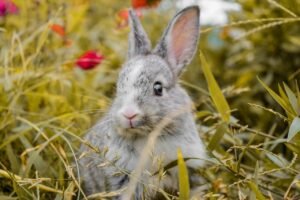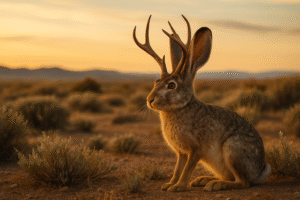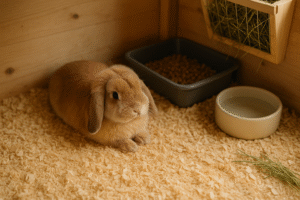The chestnut rabbit color features a unique mix of black and yellow pigments, forming a distinct brindled agouti pattern. This color is common in many rabbit breeds and is highly valued by enthusiasts for its natural appearance. In fact, chestnuts are the most common of all the agouti colors in rabbits. In this guide, we’ll discuss the genetics behind this color, how to identify chestnut kits, their developmental changes, and tips for proper care.
Key Takeaways
-
Chestnut agouti rabbits exhibit a unique color achieved through the interaction of black and yellow pigments, characterized by rich brown eyes and a complex agouti gene pattern. They also commonly have distinct, lighter markings on their bodies.
-
Recognizing chestnut agouti kits involves observing their initial pink coloration, which gradually transforms into a distinctive blend of chestnut shades as they mature, marked by significant developmental changes, including a transition in eye color.
-
Understanding the genetic markers and care tips is crucial for breeding chestnut agouti rabbits, which include regular grooming and awareness of their unique coat patterns and common breeds like Holland Lop and Mini Rex.
Chestnut Agouti Overview

The chestnut agouti color is often hailed as the quintessential rabbit color, commonly seen in wild rabbits and beloved by breeders and pet owners alike. Black and yellow pigments uniquely interact to form this captivating solid color, giving it a natural, brindled appearance. The ruby-eyed white variety adds to the diversity of rabbit colors appreciated by enthusiasts.
At the heart of this color lies the agouti gene, which influences the banding of eumelanin (black pigment) and pheomelanin (yellow pigment) along the hair shaft. This banding is crucial for the chestnut agouti’s characteristic appearance. A chestnut rabbit’s fur consists of a banded pattern with a dark slate-blue undercolor, an intermediate band of orange or creamy-yellow, and black-tipped guard hairs. The agouti pattern is complex and involves several major genes, identified as loci:
-
A
-
B
-
C
-
D
-
E
Each contributes to the rabbit’s overall coat color.
One of the most distinctive features of chestnut agouti rabbits is their rich brown eyes, which add to their warm and earthy appearance. The interplay of various pigments and genetic markers results in a color that is both vibrant and harmonious, making chestnut agouti rabbits a favorite among rabbit colors.
The agouti group includes chestnut, but it also encompasses a variety of other fascinating hues, such as chocolate agouti, chocolate chinchilla, blue chinchilla, and lilac agouti. Each color within this group has its own unique charm and genetic makeup, providing endless possibilities for rabbit enthusiasts to explore and enjoy.
Recognizing Chestnut Kits

For any rabbit breeder or enthusiast, recognizing chestnut agouti kits is an exciting experience. These kits usually appear completely born pink at birth, which is surprising considering their eventual rich coloration. However, newborn chestnut kits are often entirely black except for their agouti or broken markings. This initial pink to light brown coloration, with darker shading on their sides, sets the stage for the beautiful transformation that lies ahead.
As chestnut agouti kits begin to grow, their coloration undergoes significant changes. They may develop a smutty orange coloration with tort-like shading, which helps distinguish them from other agouti types. This unique blend of colors is a hallmark of the chestnut agouti and a delight to observe as the kits mature.
Watching the chestnut agouti pattern gradually emerge as these kits grow is fascinating. The distinctive banding and shading become more pronounced, revealing the rich tapestry of colors that define this beautiful variant. Recognizing and appreciating these early stages is key to understanding and breeding chestnut agouti rabbits successfully, especially when considering the unique agouti markings.
Developmental Changes
The journey from kit to adult for chestnut agouti rabbits is marked by a series of captivating developmental changes. Initially, these rabbits start with a darker fur pattern, which gradually becomes lighter as they mature. This transition is a natural part of their growth and adds to their unique charm.
As chestnut agouti rabbits grow, their fur coloration undergoes a gradual change, featuring a mix of light and dark shades that create a visually appealing contrast. As chestnut rabbits age, they lighten to a medium brown. The coat of an adult chestnut agouti rabbit is a true testament to the beauty of nature’s palette, with each hair shaft displaying bands of color that blend harmoniously.
One notable change during this developmental phase is the transition in eye color. As chestnut agouti rabbits reach adulthood, their eye color changes to a rich brown, complementing their overall appearance. This eye color transition is a distinctive feature of the chestnut agouti and adds to their expressive and warm look.
Additionally, the fur of chestnut agouti rabbits shows more pronounced ticking as they age. This ticking, or the presence of black-tipped guard hairs, becomes more visible and adds depth to their coat. Adult chestnuts have a gray undercoat that may be visible on their sides, ears, and face. Understanding these developmental changes is crucial for anyone looking to breed or care for chestnut agouti rabbits, as it helps in predicting and appreciating their mature appearance.
Comparison with Similar Colors

Comparing chestnut agouti with other similar colors can be an enlightening exercise, especially when trying to distinguish between various agouti variants. One of the closest comparisons is with chocolate agouti, which features chocolate tips on the guard hairs, giving it a warmer appearance compared to the black-tipped chestnut agouti. Compared to other colors, such as chinchillas, chestnuts are often described as being more common and identifiable.
Another closely related color is the chocolate chestnut, which displays a chocolate base with slightly lighter shades. While both chestnut agouti and chocolate chestnut share similarities, the chocolate chestnut’s undercoat is generally lighter, providing a subtle yet noticeable difference. This variation in the undercoat can help breeders and enthusiasts identify each color more accurately.
Chestnut agouti is also compared to other agouti colors like chocolate agouti and chocolate chestnut due to their similar appearance. However, the combination of orange and black in the guard hairs of chestnut agouti sets it apart from the chocolate variants, which have a more uniform coloration.
Understanding these subtle differences in color patterns, undercoats, and guard hairs is essential for anyone involved in rabbit breeding or showing. It not only helps in accurate identification but also enhances the appreciation for the diverse and beautiful world of rabbit colors.
Genetic Markers
The chestnut agouti color is a fascinating example of genetic expression in rabbits. The genetic markers associated with this color are represented as AB_C_D_E, which denote the dominant alleles across all major genetic loci. These dominant alleles play a crucial role in defining the chestnut agouti color.
The chestnut agouti color is determined by a combination of dominant and recessive gene alleles, with the dominant alleles always being expressed in the phenotype. This interplay of genetic markers results in the rich and varied coat color seen in chestnut agouti rabbits. Homozygous alleles produce the same genetic instruction pair, while heterozygous alleles contain different instructions, leading to varied coat color expressions.
Interestingly, almost all other rabbit colors derive from mutations of the genes responsible for the chestnut agouti coloration. Certain mutations, such as the steel gene, can produce dominant color patterns that overshadow the chestnut’s orange pigment. Breeders seeking specific color outcomes need to grasp these genetic markers and their influence on rabbit coloration.
The genetic diversity within the rabbit color spectrum is both a challenge and a delight for breeders. By grasping the fundamentals of chestnut agouti genetics, enthusiasts can better predict and appreciate the wide array of colors that can emerge from their breeding programs.
Coat Patterns and Variations
Chestnut agouti rabbits are renowned for their distinctive coat patterns and variations. These rabbits exhibit a rich chestnut color with black-tipped guard hairs and distinctive black markings in their ears. This combination of colors creates a visually stunning and unique appearance.
Dark ticking is a noticeable characteristic of the chestnut agouti pattern, affecting the appearance of individual hair shafts. This ticking, combined with the lighter undercoat, adds depth and dimension to their coat. The guard hairs in chestnut agouti rabbits are primarily black, which enhances the contrast with their lighter underwool.
Key features include:
-
Dark ticking on individual hair shafts
-
Lighter undercoat providing depth and dimension
-
Primarily black guard hairs enhancing contrast with the lighter underwool and dark gray tones, including the presence of black tips and black otters. The overall appearance of the siamese sable appears lighter due to this contrast and light shading.
When examined closely, the wool texture of chestnut agouti rabbits displays bands of tan and slate colors, creating a tan pattern that is a hallmark of the agouti pattern and contributes to the overall aesthetic appeal of these rabbits. Chestnut rabbits have an orange intermediate band of color on each hair, which adds to their unique and striking appearance. Understanding these coat patterns and variations helps in appreciating the intricate beauty of chestnut agouti rabbits.
Care Tips for Chestnut Rabbits

Caring for chestnut agouti rabbits requires attention to detail and regular grooming to maintain their health and appearance. Regular grooming involves brushing every three days to prevent fur clumping and assist with shedding. During heavy shedding periods, daily brushing is essential to avoid gastrointestinal issues from fur ingestion.
Using appropriate grooming tools designed for rabbits ensures the safety and comfort of their delicate skin. Additionally, cleaning around the eyes with moistened cotton balls helps prevent irritation and potential infections. Trimming nails once a month is crucial to avoid injuries and ensure the rabbit’s comfort.
Regular checks for pests such as fleas and mites are necessary to maintain the overall health of chestnut rabbits. These grooming and health care practices contribute significantly to the well-being and quality of life of chestnut agouti rabbits. Following these care tips helps owners keep their rabbits healthy, happy, and beautiful.
Popular Breeds with Chestnut Color

Several popular rabbit breeds exhibit the chestnut agouti coloration, making them favorites among rabbit enthusiasts. The Holland Lop breed, known for its friendly temperament and compact size, often displays the chestnut color variant, making it a popular choice among rabbit owners. These rabbits are not only charming but also easy to handle, making them ideal pets.
Another breed that commonly exhibits the chestnut agouti coloration is the Mini Rex. These rabbits are characterized by their soft, velvety coat, which enhances the rich color of their fur. Mini Rex rabbits are appealing for both pets and shows, thanks to their unique velveteen coat and friendly nature.
These breeds, with their distinctive fur types and temperaments, highlight the versatility and beauty of chestnut agouti rabbits. Whether you’re looking for a pet or a show rabbit, these breeds offer a wonderful combination of appearance and personality.
Summary
In conclusion, the chestnut agouti rabbit is a fascinating and beautiful example of rabbit coloration. Understanding their unique characteristics, developmental changes, and genetic markers provides valuable insights for breeders and enthusiasts alike. By recognizing the distinct features of chestnut agouti kits and appreciating the subtle differences between similar colors, one can truly appreciate the diversity within the rabbit world.
The care tips provided ensure that chestnut agouti rabbits remain healthy and well-groomed, enhancing their quality of life. Popular breeds like the Holland Lop and Mini Rex highlight the widespread appeal of the chestnut agouti coloration, making them favorites among rabbit owners.
Embrace the world of chestnut agouti rabbits and discover the joy and beauty they bring. Their rich colors, unique patterns, and delightful personalities make them a treasure in the rabbit kingdom.
Frequently Asked Questions
What is the chestnut agouti color in rabbits?
The chestnut agouti color in rabbits is characterized by a blend of black and yellow pigments, creating a brindled appearance that resembles the original color of wild rabbits.
How can I recognize chestnut agouti kits?
You can recognize chestnut agouti kits by their initial pink color, which changes to a light brown with darker shading and may develop smutty orange and tort-like coloration as they mature. Observing these color changes is key to identifying them.
What are the genetic markers for chestnut agouti rabbits?
Chestnut agouti rabbits are characterized by the genetic markers A_B_C_D_E_, which denote dominant alleles at major loci. Understanding these markers can help in rabbit breeding and genetics studies.
How do chestnut agouti rabbits’ coats change as they mature?
Chestnut agouti rabbits’ coats lighten as they mature, displaying more defined ticking and transitioning to a rich brown eye color. This change enhances their overall appearance and distinctiveness.
What are some popular breeds that exhibit chestnut agouti coloration?
Popular breeds that exhibit chestnut agouti coloration include the Holland Lop and Mini Rex, both appreciated for their friendly temperaments and striking appearance.



